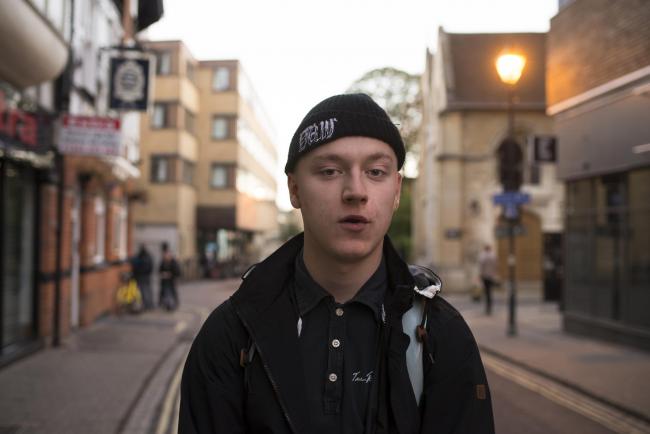A clean cut young woman in full academic dress walks out of the Bodleian Quad, flanked by two male students, in white bow ties and flowing gowns.
The good looking trio, stride purposefully across the cobbles of Radcliffe Square, heads held high, oozing entitlement and privilege. One clutches a book on the Pre-Raphaelites, another a volume on classical civilization.
The unsmiling young men have their noses in the air in a parody of cartoon snobbery. All have immaculately coiffured hair.
Then we cut to a black man of similar age in trendy street wear and woollen hat framed by the same buildings outside the Divinity School. He starts rapping, as does a young white man in similar attire.
They move from the iconic architecture of Oxford’s old centre to the back streets and estates on the city’s edge where no tourist goes.
It’s not subtle, but it makes a point: Oxford is a divided city – as if we didn’t know – made up of different realities, often superimposed.
Visual artist Penny Woolcock’s show Fantastic Cities at Modern Art Oxford is all about alternative experiences of the same spaces.
“I am haunted by the way our city, any city, is experienced in different ways,” she says. “We all have our individual lives and stories that follow us onto the pavement but we inhabit shared public spaces in radically different ways.
“For some the city is a playground, for others a battlefield, but humour and acts of kindness burst through the cracks to give us hope.”
Since the show launched at the Pembroke Street gallery late last year, Fantastic Cities has enthused the art world, with critics, commentators and broadcasters decamping from London for this, the first major solo exhibition of the artist and director’s work.
For Penny, it is a homecoming of sorts. While she was born in Argentina and moved to Barcelona at 18, she spent her formative years as an artist in Oxford, after moving here with her young son. She stayed for 15 years, living in Jericho and, in 1977, helped to establish the Oxford Printmakers Co-operative, which is still going strong.
Now living in London, the capital and its depressingly prevalent gang culture features heavily.
The hardest-hitting piece in the show is her beautifully edited and slickly narrated short film When the Same Road is a Different Road, which interweaves her experience of living in the gentrified Caledonian Road area of Islington with those of gang members. Where she sees gastropubs serving prosecco on tap and shops selling olives, members of the Cally Boyz navigate a patchwork of safe and danger zones where the unwary face being stabbed and killed at any moment.

The same eye is brought to Oxford in Dreaming Spires, with rappers Side and ‘Black Jack Tha Activist’ moving beyond the hallowed quads and the University Church out to Blackbird Leys and the flats of Preachers Lane, just across Thames Street from the new Westgate. Beanie-hatted rapper Side spits out lyrics as he straddles the paint-splattered site of what was north Oxford’s Snob Walls which separated privately owned homes from council houses in Sunnymead.
Dreaming Spires is screened in sequence with La La Land, which attempts to do the same for Los Angeles, highlighting the even deeper divisions which exist there between glitzy Beverley Hills and the homeless camps of Skid Row downtown.
READ MORE: Faces of modern Tibet at Oxford museum
READ MORE: The year's best gigs. Look who's playing Oxfordshire in 2019
It’s all fairly obvious, but well done and almost hypnotic, as one might expect from the woman who created the sublimely poetic 2012 mash-up of archive footage about the UK coast, From The Sea to the Land Beyond, soundtracked by the band British Sea Power.
The idea of contrasting different people’s interpretations of the same thing is brought into dramatic relief in another film piece, When I First Saw a Gun. This records the experiences of interviewees from along the social spectrum, handling their first firearm – whether in the context of gangs, crime, war or blood sports.
Elsewhere she explores urban regeneration and the destruction of communities, and her own impression of herself as a teen, in an enormous stitched and stuffed textile model of herself, rendered in what look like old flesh-coloured tights, called, appropriately Big Girl. It is graphic in its (quite literally) ‘in your face’ nudity and fills an entire room.
“Penny has been engaged since she was a teenager in the idea of different people living alongside each other seeing cities in different ways,” says the show’s curator Emma Ridgway.
“Penny moved here when she was 20 and was shocked at the reality of life in the UK in terms of class differences and forms of poverty she hadn’t expected to see.

“She had a happy time in Oxford, though, and seemed to reach a turning point from seeing big bold exhibitions here and meeting women artists who gave her the confidence to think ‘I can do this’.
“She was emboldened and saw what you could do collectively at a time of her life when she could have been quite isolated.”
As well as her work with the Oxford Printmakers she borrowed equipment from Film Oxford and began making films. Her breakthrough drama was the critically-acclaimed Tina Goes Shopping made in collaboration with the residents of a housing estate in Leeds. She then started focussing on gangs, which brings us to Fantastic Cities.
“It’s about seeing things as others see things,” says Emma. “It’s not a soft show.”
- Penny Woolcock: Fantastic Cities, Modern Art Oxford, Pembroke Street, Oxford. Until March 3. Free








Comments: Our rules
We want our comments to be a lively and valuable part of our community - a place where readers can debate and engage with the most important local issues. The ability to comment on our stories is a privilege, not a right, however, and that privilege may be withdrawn if it is abused or misused.
Please report any comments that break our rules.
Read the rules here